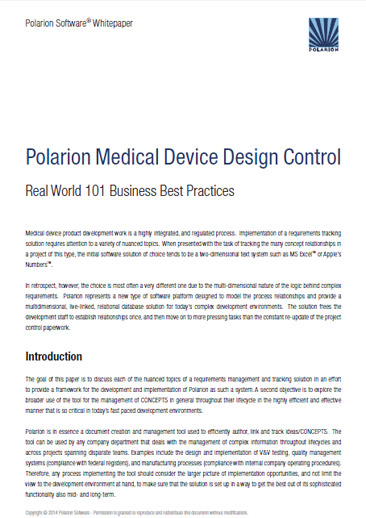Medical Device Design Control (Part 1 of 3)
Medical device product development work is a highly integrated, and regulated process. Implementation of a requirements tracking solution requires attention to a variety of nuanced topics. In this 3-part series, we’ll present a practical approach derived from real-world experience developing medical devices using Polarion solutions.
When presented with the task of tracking the many concept relationships in medical device projects, the initial software solution of choice tends to be a two-dimensional text system such as Microsoft Excel® or Apple Numbers™.
In retrospect, however, the choice is most often a very different one due to the multi-dimensional nature of the logic behind complex requirements. Polarion represents a new type of software platform designed to model the process relationships and provide a multidimensional, live-linked, relational database solution for today’s complex development environments. The solution frees the development staff to establish relationships once, and then move on to more pressing tasks than the constant re-update of the project control paperwork.
What’s coming your way
The goal of this blog series is to discuss each of the nuanced topics of a requirements management and tracking solution in an effort to provide a framework for the development and implementation of Polarion as such a system. A second objective is to explore the broader use of the tool for the management of CONCEPTS in general throughout their lifecycle in the highly efficient and effective manner that is so critical in today’s fast paced development environments. The main topics of this series will include:
- Concept Management (read on)
- Traceability Matrix (coming in part 2)
- Document Definition (coming in part 3)
So let’s get started.
What does a CONCEPT management system do?
Polarion is in essence a document creation and management tool used to efficiently author, link and track ideas/CONCEPTS. The tool can be used by any company department that deals with the management of complex information throughout lifecycles and across projects spanning disparate teams. Examples include the design and implementation of validation and verification(V&V) testing, quality management systems (compliance with federal registers), and manufacturing processes (compliance with internal company operating procedures). Therefore, any process implementing the tool should consider the larger picture of implementation opportunities, and not limit the view to the development environment at hand, to make sure that the solution is set up in a way to get the best out of its sophisticated functionality also mid- and long-term.
Essentially, what a concept management system is designed to do is to break documents down into their essential building blocks. These blocks are then connected on the basis of their definition and logical relationships to constitute workflows that can accomplish given tasks.
For example, in the case of a Design Proof, a product requirements document could be broken down into user needs, system requirements, mechanical requirements, and software requirements. The mechanical requirements are then broken down further into sterilization, packaging, and transit requirements. Because each of these CONCEPTS is logically different and tagged independently, they can be sorted and subjected to unique workflows. For instance, the sterilization needs could be copied into a micro-biology review, and the user needs could be collected into a validation test. And, each of the workflows can be managed interdependently.
Another example is Quality Management. When, for instance, a company receives a register of legal requirements and guidance on system compliance from the government, such can be broken down into its specific legal requirements, which can then be individually satisfied by company standard operating procedures. Because there is clarity in the unique categorization of each individual work item, which is extended through issue-, change-, and variant- management, the records proving compliance can be easily verified in an audit, much like a product design verification processes.
 The genius of Polarion is that it enables the creation of documents as well as the logic behind them, and tracks them interdependently. The CONCEPTS including their sophisticated multi-dimensional relationships can be stored and tracked in Polarion, or released as a complete document into a traditional PLM tool (Agile, Arena Solutions, Image Silo, etc…). In either case, specific reports and documentation for internal reviews as well as external audits can be generated real-time, any time, to provide the accurate status of your projects. This is very different from a traditional PLM (Product Lifecycle Management) tool, which manages the entire document, not concepts inside the document, making processes much more cumbersome at best.
The genius of Polarion is that it enables the creation of documents as well as the logic behind them, and tracks them interdependently. The CONCEPTS including their sophisticated multi-dimensional relationships can be stored and tracked in Polarion, or released as a complete document into a traditional PLM tool (Agile, Arena Solutions, Image Silo, etc…). In either case, specific reports and documentation for internal reviews as well as external audits can be generated real-time, any time, to provide the accurate status of your projects. This is very different from a traditional PLM (Product Lifecycle Management) tool, which manages the entire document, not concepts inside the document, making processes much more cumbersome at best.
Next time: Traceability Matrix: Design V&V
DON’T WANT TO WAIT?
Download our new whitepaper with the full series content now
Polarion Medical Device Design Control – Real World 101 Business Best Practices
Comments
Leave a Reply
You must be logged in to post a comment.





Interesting! Looks like Polarion could really streamline the whole medical device development process. Excel just doesn’t cut it for complex requirements, you know? Definitely gonna check out the other parts of the series. By the way, if anyone’s interested in exploring AI-powered design tools, I’ve been using an AI design agent called Lovart (https://lovart.ai) and found it really helpful for creative projects.